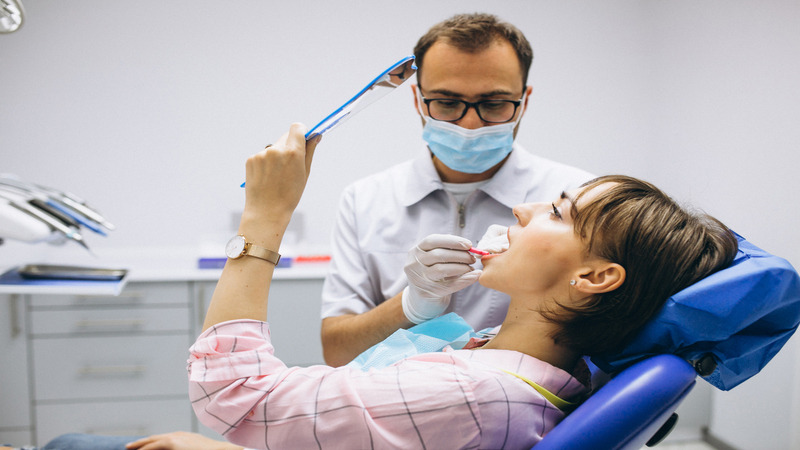Sleep is one of the most vital aspects of our health and well-being, yet many people struggle with poor sleep quality due to various factors, including breathing issues. What many may not realize is that dental health plays a critical role in improving both sleep and breathing. There are several dental procedures that can address problems like sleep apnea, snoring, and airway obstructions, leading to better sleep and overall health. Let’s explore some of these dental treatments and how they can benefit you.
1. Oral Appliances for Sleep Apnea
One of the most common sleep disorders is obstructive sleep apnea (OSA), a condition where the airway becomes blocked during sleep, causing pauses in breathing. Continuous Positive Airway Pressure (CPAP) machines are often prescribed, but for many, they can be uncomfortable or difficult to use. Dental solutions such as custom-made oral appliances offer an alternative. These appliances reposition the lower jaw and tongue to keep the airway open, reducing snoring and apneas. They are small, portable, and much easier to use compared to CPAP machines.
Benefits of Oral Appliances:
- Improved airflow during sleep
- Reduced snoring
- Easier to use and travel with than CPAP machines
2. Orthodontic Treatments to Expand Airway
Crooked or misaligned teeth can contribute to restricted airflow, particularly when lying down. Orthodontic treatments like braces or clear aligners can correct bite issues (malocclusion) and help expand the airway. In some cases, palatal expanders are used, especially in children, to widen the upper jaw. This can lead to better airflow through the nasal passages, reducing the likelihood of breathing issues that affect sleep quality.
Benefits of Orthodontic Treatments:
- Enhanced airway space
- Prevention of sleep-disordered breathing in children
- Long-term improvement in bite alignment and aesthetics
3. Surgical Procedures to Correct Jaw Alignment
For patients with severe structural issues in their jaws, orthognathic surgery may be necessary. This surgery repositions the upper and/or lower jaw to correct issues like overbite, underbite, or misalignment. Misaligned jaws can lead to obstructed airways, especially during sleep. By correcting the jaw’s position, this surgery can significantly improve breathing and reduce sleep apnea symptoms.
Benefits of Orthognathic Surgery:
- Long-term resolution of severe sleep apnea
- Improved facial appearance and dental function
- Enhanced breathing during sleep and wakefulness
4. Tongue-Tie Release (Frenectomy)
A tongue-tie (or ankyloglossia) is a condition where the tissue connecting the tongue to the floor of the mouth is too tight, restricting tongue movement. This can lead to breathing and speech issues, particularly in children, and even contribute to sleep apnea. A simple procedure called a frenectomy releases the tongue-tie, allowing for better tongue movement and more natural breathing.
Benefits of Frenectomy:
- Improved tongue mobility
- Better breathing and reduced snoring
- Easier breastfeeding for infants with tongue-tie
5. Treatment for Bruxism (Teeth Grinding)
Bruxism, or teeth grinding, can be linked to sleep disturbances and even breathing issues. Teeth grinding often occurs during sleep and can narrow the airway, making it harder to breathe. Dentists often prescribe custom-made occlusal guards that protect the teeth and help maintain proper jaw alignment, which can also improve airflow.
Benefits of occlusal guards for Bruxism:
- Protection of teeth from damage
- Improved jaw alignment and breathing
- Reduction in sleep disturbances related to grinding
6. TMD Treatments for Jaw Disorders
Temporomandibular joint disorders (TMD) can cause pain and discomfort in the jaw, face, and neck, and may also affect breathing. A misaligned jaw can lead to airway obstruction, contributing to poor sleep quality and conditions like sleep apnea. Dental treatments for TMD, such as bite splints or physical therapy, can alleviate these issues and improve sleep.
Benefits of TMD Treatments:
- Relief from jaw pain and headaches
- Better jaw alignment for improved breathing
- Enhanced sleep quality
Conclusion
Good dental health isn’t just about having a bright smile—it can also play a critical role in your sleep and breathing. Dental procedures like oral appliances, orthodontic treatments, and even surgical interventions can help improve airway function, reduce sleep apnea symptoms, and enhance overall sleep quality. If you struggle with sleep or breathing issues, consulting with a dentist who specializes in sleep-related problems could be the key to better rest and better health.
